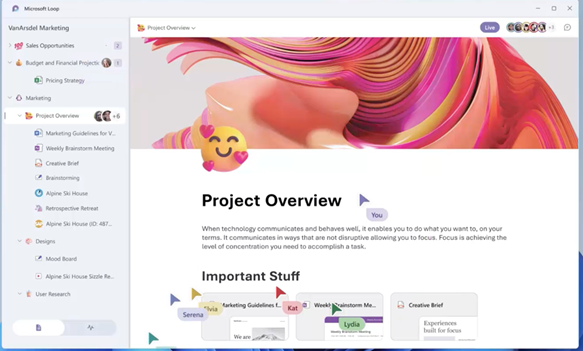At Ignite 2021, Microsoft announced a new Office application called Loop, providing another Office 365 tool to collaborate and run projects.
For folks who aren’t following the latest productivity app trends, your reaction is likely something like, “but don’t we already have Teams for collaboration?”. Loop serves a different purpose from Teams. It compares best with tools like Coda or Notion. The idea behind these new collaboration tools is to provide a flexible canvas where people can track various pieces of information (live or static) for projects or initiatives. For those familiar with SharePoint, think of it as more like SharePoint pages that multiple people can edit simultaneously, with webparts (now called Loop Components, more on that below) to display information.
Let’s briefly go over how information is organized in Loop.
Loop has three main parts:
- Loop Workspaces
- A container that represents a project or initiative.
- Loop Pages
- A page to organize information.
- Loop Components
- A piece of information, from the simple text box to the more complicated live embed of Dynamics information. The interesting thing about these Components is they can be live and third parties will be able to create their own. In addition, these Components use a technology that Microsoft had called Fluid. They can be displayed in other locations such as Teams, Outlook or OneNote and still be live. This means the Component is kept in sync so that people can edit it from Teams, Outlook, OneNote or Loop all at the same time.
Loop vs. Teams
The collaboration piece of Teams is centered around communication between people. Chats, Teams channel posts, audio calls, video calls, meetings (accessing calendars for those meetings) are all centered around people communicating with each other. I haven’t tried Loop myself, but it seems to be more centered around information and allowing people to collaborate on that information. Having Loop Components embedded in Teams will form a bridge between the two apps, allowing people to collaborate about the information and collaborate on the information. With that being said, when would I use Loop as the primary tool and Teams for support? If the information is at the center of the project, I would use Loop. If my primary need is to communicate with my team, I would use Teams. As the integration between the two tools improves, I suspect this decision won’t need to be made at all.

Contact Us
Not sure where to start with Microsoft Loop? Contact a member of Withum’s Digital and Transformation team today.
Why Loop and Why Now?
I’ve lived in the SharePoint world for more than a decade, so SharePoint is known to me, but many people struggle with it at first. Things like how to organize pages well are not that straightforward. Loop is much more of a product, with a specific structure that must be followed. For example, it doesn’t seem to have nested pages or even containers to organize pages within a workspace (at least not yet). It’ll be interesting to see how the product evolves and how many companies invest in creating Components.
Learn more about Microsoft Loop here.
Insights

Microsoft 365 Adoption Announcements from Microsoft Ignite – What Do They Mean for Your Adoption Strategy?
Last week Microsoft held its annual Ignite conference where Microsoft experts shed light on new and exciting technologies and tools, including Microsoft 365 and user adoption. This year was no […]



